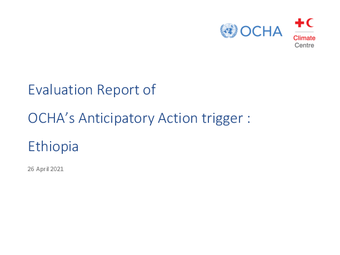Categories
Evaluation Report of OCHA's Anticipatory Action Trigger: Ethiopia (26 April 2021)
This report aims to identify the strengths and limitations of UN OCHA’s Anticipatory Action trigger in Ethiopia, by examining both the development process and the effectiveness of the trigger mechanism. Key findings focus on 1) streamlining the process for ongoing trigger refinement and development, 2) strengthening top-down/bottom-up linkages between the trigger design and targeted action planning processes, and 3) iterative adjustment informed by coupling evaluation of the trigger with impact assessment, integrated within the context of Ethiopia’s full humanitarian intervention cycle.
Several timeline tools have been derived from research informed by interviews with stakeholder groups to assist in visualising the trigger cycle and support integration, sequencing and coordination among the technical and implementation partners as part of the on-going trigger assessment and adjustment cycle. Further details on the trigger analysis methods and findings are provided in the full report and appendices. Appendices include a synthesis of key learnings from Ethiopia’s trigger experience that can help to inform anticipatory action trigger development processes elsewhere. Key recommendations based on findings are summarized below, with three timeline tools as visual aids:
1. Streamline Ethiopia’s trigger monitoring & continuing development process
Recommendations for trigger streamlining in Ethiopia encompass clarifying the process with a sequencing timeline, while also building transparency and ownership among implementing partners at the country level in order to cultivate effective demand for further trigger development:
- Progressively automate the trigger so that decisionmaking is more data-driven based on scientific observations and analysis, while also involving stakeholders in threshold-setting - which requires subjective decisions.
- Use a sequencing timeline (Figure A) as a tool to clarify the process for integrating observational data sets, climate outlooks and food security outlooks within the trigger, and to align action planning (including a ‘stop mechanism’) and sectoral interventions with Ethiopia’s seasonal calendar.
- Consider further developing the role of OCHA’s experimental dashboard as an objective visualisation tool for monitoring the trigger, to provide more of a decision tree, as well as transparency to a widening set of stakeholders.
2. Strengthen top-down/bottom-up linkages between Ethiopia’s trigger design team and targeted action planning teams
The top-down, largely OCHA-driven, trigger design process needs to increasingly involve national stakeholders at key decision points to review and improve Ethiopia’s trigger and in order to build buy-in for demand-driven development and expanding use of the trigger. The trigger design process was not adequately connected w/targeting, resulting in implementation delays following triggering. Clear feedback loops between the trigger design team and targeting team need to inform the continuing process of trigger refinement and development. This will need to take into consideration both the return period of forecasts and the phasing of early action. Building “bottom-up” buy-in through explicit process linkages is also crucial to advance anticipatory action as a fully integrated normalized way of working, and to ensure the sustainability of Ethiopia’s trigger mechanism.
Key recommendations for strengthening trigger design and targeting linkages:
- The Process Timeline for AA in Ethiopia (Figure B) can serve as a guidepost in systematizing process timelines and sequencing to strengthen multi-stakeholder engagement & coordination, especially in adjusting the trigger return period and refining leadtimes.
- Continual improvement of trigger design requires closing top-down/bottom-up feedback loops with stakeholders; this also builds the support, transparency & inclusion which are keys to ownership, and sustained involvement of on-the-ground partners in the AA process.
- Fully integrating AA helps to change mindset, enabling a growing roster of implementing partners to act earlier on, in a more flexible, nimble, agile way; Ethiopia’s trigger sets the stage for harnessing AA to scale up and out, as a strategy to cope with uncertainty and build resilience, also harnessing good conditions in a changing climate.
3. AA success = Impact + Learning -> Iterative cycle of continual improvement
Ethiopia’s anticipatory action trigger worked well however it involved an unanticipated phased activation. This timeline indicates a proposed sequencing for a phased trigger, including a clear demarcation of the transition to response. Possible adjustment should be expected to further refine and tailor the trigger following every activation. Over the course of iterative activation, assessment should focus on the effectiveness of each phase of action triggered as well as the effectiveness of the overall phased approach. Assessing the effectiveness of the trigger should be integrated into the assessment of the impact of the actions it is used to trigger. Iterative, inclusive and integrated trigger evaluation is fundamental to making incremental improvements to the trigger mechanism as well as stimulating continuing stakeholder learning, capacity building and demand for anticipatory action.
- Improving trigger effectiveness requires iterative evaluation of the trigger to be coupled with anticipatory action impact evaluation.
- Conduct a post-activation trigger evaluation as part the MEAL (monitoring, evaluation, accountability and learning) methodology for impact evaluation every time trigger activation occurs, as illustrated in the sequencing timeline (Figure C).
- Expect potential adjustments to both trigger and actions, based on after-action analysis; also ensure that trigger and AA assessment and learning are linked to and inform evaluation of overall response effectiveness.


